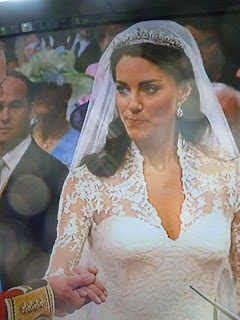
I am so excited that this is the week that we will find out who has designed Kate Middleton's dress and what it looks like. In the history of royal weddings there has never been such speculation about not only what the bride's dress will look like but also who has designed it.
Bruce Oldfield would prove a link to the past and specifically to William's late mother or could it be one of Alice Temperley's modern fairytale dresses, loved by many upper-middle-class brides, would maintain the status quo of Kate Middleton's feminine and relatively safe aesthetic but if it is Sarah Burton that surely would be a bold gesture, announcing a fiercely up-to-date princess.
My excitement is mounting with the odds being on Sarah Burton. I just want sometime different, something special, something that makes Kate feel and look fabulous and something that cannot be cheapened by them coping it within hours. Please may it have unique embroidery and do something to inspire brides throughout the country to be daring to have something different and something personal to reflect who there are.
It has to be a British Designer,this is surely one of the few things we can assume about the dress. That is why I haven't listed Daniella Issa Helay,the Brazilian-born designer who did Kate's dress for the engagement day. It would be unpatriotic on a day when the whole world is watching Great Britain but also very "off-trend" - even Michelle Obama wears British designers these days. Of course, it's also traditional for a royal bride. As Joanna Marschner, the senior curator at Kensington Palace, points out, in the past royalty did everything it could to promote the "Made in England" message, utilising British-produced fabrics.
I was talking to one of the Bridal Worlds leading producers at the weekend and she said that surely it would influence our industry and give us a much needed boost. Princess Elizabeth's romantic Norman Hartnell dress lifted postwar Britain's spirits. Since Queen Victoria the 'best of British' tradition became standard practise. Then the queen and her advisors decided the entire ensemble should be British-made, and promote the country's arts and crafts and lace industry. Thus, the silk-satin was woven in Spitalfields; and the lace for the deep flounce to decorate the skirt, was woven in Honiton and Beer, to a pattern of exotic flowers and scrolling foliage, designed by the distinguished, Scottish, pre-Raphaelite painter, William Dyce, the head of the new Government School of Design, later to become the Royal College of Art. Royal weddings became an opportunity to promote the best of British industry. I wonder could Kate's dress have the same influence, I wish.
Already there is a race on to be the first with a look-alike. "When the dress hits, we will be right on it," says Jim Hjelm, a bridal designer in New York. "We'll be on the computer that afternoon,sending a sketch." The company's factory in China will return samples within 24hours. Forget the idea of copyright laws, so long as there are subtle modifications no one can stop them.

So please for the sake of us all can we have an edgier wedding gown for the future royal. "The Royal wedding will be magical. Kate's dress should be a modern mix of traditional and contemporary" Monique Lhuillier.


















